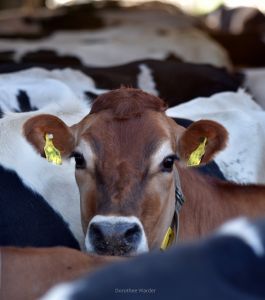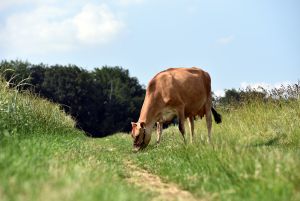Jersey

A typical picture from German barns - the small but assertive Jerseys in the middle of a Holstein herd (Photo: D. Warder)
Organised Jersey breeding started in Germany in the 1950s. Originally, the breed comes from the British Channel Island of Jersey. The low body weight compared to fat and protein yield and the significantly lower requirement for forage production were the main arguments for establishing Jersey herds throughout Germany. This breed scores particularly well in the area of high contents. In addition, there is a high adaptability, also to different climatic conditions, with best feed efficiency.
In total, there are about 5,000 Jersey cows in Germany on farms with milk recording. Often these are dairy farms with a majority of Holsteins. Due to the assertiveness of the strikingly smaller and lighter Jerseys, this is possible without any problems. In Jersey breeding, the goal is a height at the sacrum of around 130 cm with a live weight of 400 kg. The performance targets are defined as an average of 7,000 kg milk with 6 % fat and 4.25 % protein. By breeding for a better milk yield, the fat content was reduced to currently 5.4 %. At the top, Jersey cows reach annual yields of 10,000 kg milk. In the area of lifetime production, the best animals exceed the 10,000 kg mark for fat and protein.

Firm udders and a fine bone structure as well as a brown coat with dark spots on the head and a dark tail tassel characterise this breed (Photo: D. Warder)
Jersey heifers can be bred very early and a first calving age of 24 months is relatively common. Noticeable are the easy calvings in Jerseys. Even after mating with beef bulls the calves are born without problems. The very dry legs and dark claws bring clear advantages for all husbandry systems. This trait complex has always had a special importance in Jersey breeding, as a high longevity of the cow has to be the main focus in a single purpose cow. Due to the low economic importance of male calves, the use of female-sexed semen has become standard in many herds in recent years. At the same time, the proportion of hornless genetics in the Jersey population increased considerably.
Jerseys are very adaptable. They are particularly suitable for pasture-based dairy farming in higher rainfall conditions, such as in New Zealand, as the light animals put less pressure on the sward.










